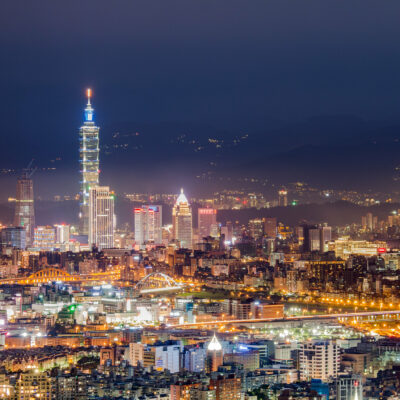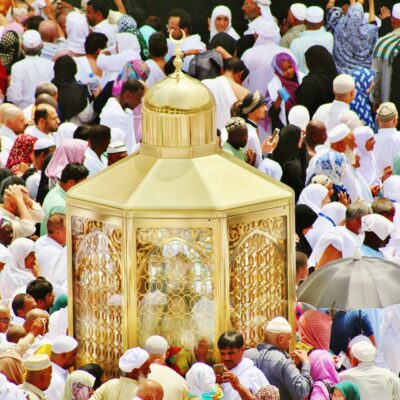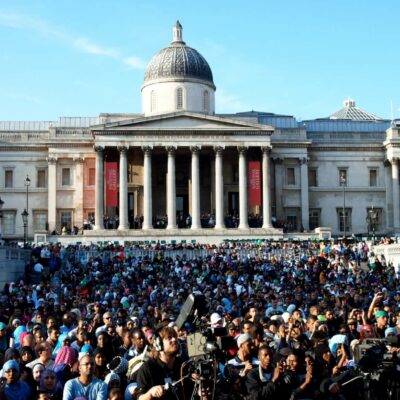‘If I may use an imagery, our society is made up of four overlapping circles [of Chinese, Malay, Indian, and Other] […] Each circle represents one community. The four circles overlap each other. What we can do is to maximize the overlapping area. This is the area where all Singaporeans, whatever their race, work and play together […] This practical approach of nation-building whereby every community has two playing fields has given us multi-racial harmony’, Former Prime Minister Goh Chok Tong.
The Singaporean government speaks, and necessarily so, of the need to maintain social cohesion embodied in its sense of multi-racial harmony.[1]
By making distinctions on race and highlighting the boundaries of circles within the larger national circle, the state has articulated a vision of Singapore as being one where each constituent ‘race’ must play its part to maintain what it sees as the nation’s fragile status. For this reason, the securitisation of Muslims in Singapore can be understood as a matter of maintaining societal security to ensure that this larger circle of which then-Prime Minister Goh Chok Tong spoke, remains secure.
Muslims and Islam in Singapore
It is worthwhile to first outline the state of Muslims and Islam in Singapore to link it to the societal security dynamic. As of the 2020 census, the ethnic composition of the resident and citizen Singaporean population was 75.9 percent Chinese, 15.0 percent Malay, 7.5 percent Indian, and 1.6 per cent ‘Other’. The same census records that 98.8 percent of Malays report being Muslim, followed by 23.4 percent of Indians identifying as such. The latter is individually noteworthy and indicative that Singaporean Muslims are by no means homogenous in ethnicity. Accordingly, by and large, to be Malay in Singapore is to be Muslim, but to be Muslim is not necessarily to be Malay. Placed in the grander scheme of things, however, with Indians comprising a smaller proportion of the overall population, the most visible minority group remains Malay-Muslims. This leads inter-religious scholar Paul Hedges to observe that the overlap of the two cohorts results in them being coterminous.
Narrowing the scope here to Malay-Muslims: there is a wealth of academic literature, stretching back decades, that articulates the state of Malay-Muslim affairs in Singapore and situates it within the broader Malay world. It is nevertheless sufficient here to focus briefly on what academics Rahil Ismail and Brian J. Shaw have persuasively argued to be the ‘rigid compartmentalisation and psychological institutionalisation of stereotypes together with political, historical and geographical baggage’ of Malay-Muslims.
This geographical baggage lends itself to scholar Khairudin Aljunied describing Singapore as ‘provincial secular state’ in that rather than being religiously cosmopolitan—bearing in mind the country’s proximity to the Muslim-majority states of Malaysia and Indonesia—it ‘discourages and even prohibits religious thinkers, scholars and popular preachers from transmitting ideas that would encourage their adherents to imagine themselves as belonging to trans-local solidarities.’ The position of the state is that religiosity must be contextual; as the then-Deputy Prime Minister Tony Tan pronounced in 2005, Malay-Muslims must choose ‘the directions they will take, rather than be swayed by foreign opinions or alien teachings which will not be appropriate for conditions here’ within ‘the context of the Singapore system’. Unpacking the construction of this system, and its sense of societal security, gives us greater clarity on the sense of where Malay-Muslims stand.
What is societal security?
Broadly, ‘societal security’ relates to threats to collective identity. Societies are made of numerous national, ethnic, and religious groupings, and threatening these units brings into question the very survival of that society. International relations scholar Paul Roe applies this more narrowly to minority rights and argues that these rights are always a matter of societal security. He asserts, that ‘to remove the language of security from minority rights […] is in essence to stop talking about group distinctiveness. In this way, it signals the death of the collectivity, of the distinct minority.’ The question is then not whether minority identities being securitised is a reality, it is how to ensure that this securitisation is moderate and not excessive. It is a dilemma the Singapore state has long faced in light of its history.
The instutionalisation of Malay-Muslims in Singapore
At its founding in 1965, Singapore embraced what the first President of Singapore, Yusof bin Ishak described as being a ‘secular, rational and multi-racial approach to economic struggles and the legacy of the colonial era.’ This multi-racial approach is embodied by the state’s promotion of the nomenclature of Chinese, Malay, Indian and Others (CMIO)—a historical product of British colonial administration. This form of hard multi-racialism is buttressed by state policies, among which is the ethnic integration policy that dictates the ethnic composition of public housing blocks; mother-tongue instruction in schools that require students of Chinese, Malay, and Indian ethnic heritage to study Mandarin, Malay, or Tamil, respectively; and state-sponsored ethnic-based welfare organisations. All of which go to varying degrees to what Ismail and Shaw assess as the state’s ‘rigid compartmentalisation and psychological institutionalisation’.
Indeed, such is the institutionalisation that there exists legislative recognition of Malays in Singapore. For instance, Article 152 of the Constitution stipulates ‘the special position of the Malays’ and enjoins the government to ‘protect, safeguard, support, foster and promote their political, educational, religious, economic, social and cultural interests and the Malay language’. Likewise, it specifies in the following article that the ‘Legislature shall by law make provision for regulating Muslim religious affairs and for constituting a Council to advise the President in matters relating to the Muslim religion.’ These form the basis of the Administration of the Muslim Law Act of 1966 (AMLA) that provides Muslims with what lawyer Ahmad N. bin Abbas calls the ‘privilege of invoking Islamic law when it comes to some matters of personal law’ but which otherwise requires Muslims to ‘stand together with other Singaporeans […] as being equal before the law.’
The AMLA legislation likewise institutionalises in the creation of the Majlis Ugama Islam Singapura (MUIS, Islamic Religious Council of Singapore), the peak statutory body tasked with ‘managing Islam’. Amongst its several stated roles is the ‘Administration of Zakat, Wakaf (endowment), pilgrimage affairs, Halal certification and other activities related to the socio-religious life of Muslims in Singapore.’ Naturally, given the breadth of opinion within the Malay-Muslim community, there are questions as to whether Muslim leadership and institutions have been co-opted into the state project.
Additional domestic institutional mechanisms further constrain the influence of regional religiosity. The aforementioned translocal solidarities are heavily localised by state instrumentation such as those requiring any Islamic religious teacher in Singapore to receive certification from the Asatizah Recognition Scheme in order to practice. The possible revocation of this certification could prove to be as Walid Abdullah suggests, ‘a powerful disincentive for a religious teacher to proffer opinions that the state may deem unacceptable’, and thus a means by which the state confines an otherwise transnational belonging within the national. Additionally, it exercises control of those abroad who may disseminate such beliefs by requiring the Miscellaneous Work Pass for any foreign visitor giving a seminar relating to religion and has denied entry to those deemed unacceptable. In 2022, for instance, the Ministry of Home Affairs refused the entry of Indonesian preacher Abdul Somad Batubara for ‘advocat[ing] violence and/or espouse extremist and segregationist teachings’.
Taken together, the accommodation of religious sensibilities amidst a larger secular national framework goes to Roe’s elaboration of minority security, wherein the ‘minority can feel secure when certain provisions/legislations/mechanisms are put in place that will guarantee its existence (in identity terms), while similarly the majority can also feel secure in the knowledge that the minority will thus work (politically, economically and also societally) within the existing framework of the state.’
Managed securitisation
‘We have no illusions about the depths of the religious fault lines in our society, and the harm that will befall us if we neglect to manage them’, Prime Minister Lee Hsien Loong.
The course of economic development that propelled Singapore from ‘Third World to First’ brought with it increasing (and surprising) levels of religiosity in the population. The modernisation thesis holds that economic development should generally correspond with declines in religious activity. However, as work by sociologist Alexius A. Pereira along with the National University of Singapore’s Institute of Policy Studies demonstrates, the reverse is true in Singapore where there is now increased religiosity, or what sociologist Chee-Kiong Tong calls the ‘rationalisation of religion’. Indeed, the government’s historical fear of a Westernisation of Singaporean society led it to lean heavily on CMIO as a cultural ballast that corresponded with greater religious affiliation. This saw the introduction of subjects in schools aimed at Buddhist studies, Bible knowledge, and Islamic education, among several others including teaching Confucian ethics. The government’s moves at managing this religiosity—rated by Pew Research as having some of the highest government restrictions on religion in the world—within an accommodative secular space are not limited to the aforementioned institutionalisation of Islam. Take, for instance, events in 2010 which saw a rise in public displays of Christian evangelising and resulted in Cabinet ministers warning that ‘religious beliefs must remain private […] [and] interaction in society should be based on secular values and arguments.’
The dramatic tensions brought on by Islamic extremism in the 21st century have tested this form of managed securitisation and, as with many of its counterparts, Singapore has had to contend with such fundamentalism. Shortly after the September 11, 2001 attacks on the USA, Singaporean authorities uncovered a terror plot by Jemaah Islamiyah (JI) that sought to launch a series of attacks against Western embassies, military installations, and a train station frequented by foreigners. The following months saw the arrest and detention of 36 individuals under the Internal Security Act. For law professor and former nominated member of parliament, Eugene Tan, this ‘public discourse of the terrorist threat was inflected with a moral panic, which linked increased Islamic religiosity and perceived Malay-Muslim separateness with increased susceptibility towards terrorism.’ How the government responded to counter this moral panic illustrates with specific programs and instruments illustrates the dimensions of managed securitisation.
Chief among these initiatives are the Inter-Racial Confidence Circles (IRCC) launched in 2002 which bring together formal and informal leaders from religious and ethnic communities. The initiative has an explicit purpose to ‘build and to strengthen the trust and confidence among the different races and to establish a viable grassroots mechanism to deal with serious racial or religious problems on the ground’. Managed securitisation in this sense is about being prepared for the eventuality of a terror attack that tears at the social fabric of society. At an announcement of the IRCC, the Minister for Community Development, Youth and Sports Vivian Balakrishnan explained the logic as such: ‘If a bomb were to go off or an incident which affects race or religion were to occur in society, people would know how to react, what to do or what to say in a positive way so that the bonds of friendship which have been built up do not get torn, and calmness and sensible rational reaction will prevail.’
Further soft law instruments such as the aptly named 2003 Declaration on Religious Harmony that is recited at inter-faith events, 2019 Commitment to Safeguard Religious Harmony, alongside established bodies like the Presidential Council for Religious Harmony reinforces the government’s top-down approach at managing the inter-faith interactions. Importantly, the networks facilitated by the government set the stage for a possible attack and delineates the norms of behaviour expected in such an extreme situation.
The moderate model Muslim
While the state has gone to lengths to securitise in moderation the threat of terrorism, so too have Muslim organisations sought to articulate a moderate identity, in response to Prime Minister Lee Hsien Loong’s call that ‘the fate of extremists who claim to act in the name of Islam will have to be decided by Muslims themselves, by reference to their own values and interests.’ The Singapore Islamic Scholars and Religious Teachers Association (PERGAS) produced Moderation in Islam: In the Context of Muslim Community in Singapore. The 2004 book sought to disassociate the Muslim community from the actions of terrorists and articulate a ‘moderate path’. Likewise, in 2003, the Al-Khair Mosque and the voluntary organisation Perdaus published ‘Muslim… Moderate… Singaporean’ which provided guidelines of moderation to Singaporean Muslims. As the author Muhammad Haniff Hassan cautions, ‘[s]hould Muslims be less forthcoming in providing their own definition of moderation, they should not be surprised if others take on this task and fill in the void.’
The government relies both on civil society organisations as well as its own members to champion the narrative of moderation. Indeed, the People’s Action Party (PAP) has strived to ensure its benches are populated with prominent Muslims who have considerable degrees of social credit in a society structured heavily along the lines of meritocracy. Both the current and immediate-past Minister in-charge of Muslim Affairs Masagos Zulkifli and Yaacob Ibrahim held pronounced positions prior to taking up membership, as the Chief Executive Officer of SingTel Global Offices and Associate Professor at the National University of Singapore, respectively.
However, underlying these representations is a trust deficit between the Malay community and the PAP that has ebbed and flowed over the years. Ibrahim, for example, recounted in an interview with Mothership how there had been distrust amongst the community towards the party with some questioning ‘Why do you want to join them? You know, they have treated us badly, national service and so on and so forth, right… there’s always this view that the party may not have been fair to the (Malay-Muslim) community. That is a backdrop that we cannot sweep under the carpet.’ Yet for many, although not all, it is better to speak within the party and its parametres than outside of it. Abdullah has documented the consequences for those who have spoken outside these implicit boundaries; such that, as he and Hassan stated, ‘Muslim activists and ulama have always operated with full knowledge of the socio-political realities in which they exist, and appreciate the consequences of crossing the acceptable boundaries.’
However, even within these boundaries, these definitions of moderation are not uniform and settled. There was considerable debates within the Muslim community as to what moderation means and how to problematise the concept, along with questions of having to speak up as suggesting the impetus of restoring confidence lies exclusively with the minority. This framing of ‘moderates’ versus ‘extremists’—which undermines the notion of societal security that sees such challenges as issues for society as a whole rather than for any individual cohort—has since been de-emphasised. This underscores the point that this is not a static landscape. Securitisation in Singapore is a well-defined space, but it is also one which undergoes constant renegotiation as time goes by.
The evolving nature of security
As Paul Hedges and Mohamed Imran Mohamed Taib astutely observe, although implicitly an organisation created to foster inter-religious dialogue, the IRCC’s historical priorities contend with terrorism. They cite the opening quotation of the ‘About Us’ page of the IRCC which features a warning by the then Minister for Culture, Community and Youth, Grace Fu, against the ‘threat of terrorism’ and promoting the corresponding role of the IRCC ‘in rallying our communities to stand together particularly in time of crisis.’ That the IRCC would primarily see the threat as emanating from terrorism is a product of its establishment. However, there are signs that this is changing.
The IRCC was renamed in 2007 as Inter-Racial and Religious Confidence Circles, and again in 2022 to the Racial and Religious Harmony Circle, highlighting, in a sense, the government’s shifting perception of where the potential areas of concern lie. This involves moving it beyond the questionable lines of what constitutes race to religion to most recently, an issue of ‘harmony’ or what the current Minister for Culture, Community and Youth Edwin Tong calls the ‘constant challenges that threaten to rip apart our social fabric.’
The security landscape in Singapore is shifting if not ever slowly. Concerns of the state no longer implicitly centre on radical Islamist terrorism but now publicly encompass hostile information campaigns and foreign interference, and far-right extremism. The latter of which is noteworthy in this context as portending to target Muslims; a point underscored by the 2020 detention of a Singaporean youth, a Protestant Christian of Indian ethnicity, who sought to murder Muslims in an attack on two mosques that was inspired by the 2019 mosque shootings in Christchurch, New Zealand.
Societal security in Singapore is premised on the fundamental peaceful coexistence of each of its constituent races. Mechanisms such as the IRCC and appeals, by both the government as well as non-government bodies, help make this a reality. Accordingly, securitisation in general, and securitisation of Malay-Muslims in particular, is a managed affair. The dynamics of which constantly shift, and new threats are emerging that may well see priorities and discursive appeals change. Ultimately, they all go towards the government’s underlying rhetoric of securing this ‘common circle’.
[1] While much of the literature refers to multiculturalism, scholarship on Singapore engages with the concept as multiracialism, owing in large part to the colonial legacies of racial assignment. Similarly, race is used interchangeably with ethnicity due to government policy. As explicitly defined in the Census of Population 2000: Administrative Report, an ‘[e]thnic group refers to a person’s race.’
Image: Sultan Mosque, Singapore. Credit: Rudy Herman/Flickr.




